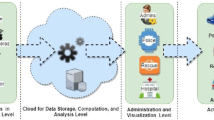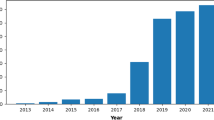Abstract
Recently, cryptocurrencies have received substantial attention by investors given their innovative features, simplicity and transparency. We here analyze the increasingly popular Bitcoin and verify pertinence of the efficient market hypothesis. Recent research suggests that Bitcoin markets, while inefficient in their early days, transitioned into efficient markets recently. We challenge this claim by proposing simple trading strategies based on moving average filters, on classic time series models as well as on non-linear neural nets. Our findings suggest that trading performances of our designs are significantly positive; moreover, linear and non-linear approaches perform similarly except at singular time periods of the Bitcoin; finally, our results suggest that markets are becoming less rather than more efficient towards the sample end of the data.










Similar content being viewed by others
Notes
Quandl is a general data market place that collects and makes available public as well as commercial data sets through a unified API. For more information, visit https://quandl.com.
The test statistic is based on \(t{\text {-test}}:=\overline{d_t}/(\sigma _{d_t}/\sqrt{T-L-1})\) where \(d_t,t=L+1,\ldots ,T\) are first differences of the performance curve (which starts in \(t=L\) where \(L=6\) is the filter length), \(\overline{d_t}\) and \(\sigma _{d_t}\) denote the arithmetic mean and the empirical standard deviation of \(d_t\), so that \((\sigma _{d_t}/\sqrt{T-L-1})\) is the standard deviation of the mean, assuming independence of \(d_t\) (null hypothesis). We rely on the t.test function in the R-package for deriving empirical significance levels of the statistic where we selected the one-sided test of the null-hypothesis of a vanishing drift against the alternative of a positive drift.
References
Al-Yahyaee, K., Mensi, W., & Yoon, S. (2018). Efficiency, multifractality, and the long-memory property of the bitcoin market: A comparative analysis with stock, currency, and gold markets. Finance Research Letters, 27, 228–234.
Alvarez-Ramirez, J., Rodriguez, E., & Ibarra-Valdez, C. (2018). Long-range correlations and asymmetry in the bitcoin market. Physica A: Statistical Mechanics and its Applications, 492, 948–955.
Bariviera, A. F. (2017). The inefficiency of bitcoin revisited: A dynamic approach. Economics Letters, 161, 1–4.
Bariviera, A. F., Basgall, M. J., Hasperué, W., & Naiouf, M. (2017). Some stylized facts of the bitcoin market. Physica A: Statistical Mechanics and its Applications, 484, 82–90.
Bartos, J. (2015). Does Bitcoin follow the hypothesis of efficient market? International Journal of Economic Sciences, 4(2), 10–23.
Baur, D. G., Dimpfl, T., & Kuck, K. (2018). Bitcoin, gold and the us dollar—A replication and extension. Finance Research Letters, 25, 103–110.
Brauneis, A., & Mestel, R. (2018). Price discovery of cryptocurrencies: Bitcoin and beyond. Economics Letters, 165, 58–61.
Brière, M., Oosterlinck, K., & Szafarz, A. (2015). Virtual currency, tangible return: Portfolio diversification with bitcoin. Journal of Asset Management, 16(6), 365–373.
Caporale, G. M., & Plastun, A. (2017). The day of the week effect in the crypto currency market. Discussion papers of DIW Berlin 1694, DIW Berlin, German Institute for Economic Research.
Carrick, J. (2016). Bitcoin as a complement to emerging market currencies. Emerging Markets Finance and Trade, 52(10), 2321–2334.
Chan, S., Chu, J., Nadarajah, S., & Osterrieder, J. (2017). A statistical analysis of cryptocurrencies. Journal of Risk and Financial Management, 10, 12.
Cheah, E. T., Mishra, T., Parhi, M., & Zhang, Z. (2018). Long memory interdependency and inefficiency in bitcoin markets. Economics Letters, 167, 18–25.
Chuen, L., Lee, D., Guo, L., & Wang, Y. (2017). Cryptocurrency: A new investment opportunity? The Journal of Alternative Investments, 20(3), 16–40.
Dyhrberg, A. H. (2016). Bitcoin, gold and the dollar—A garch volatility analysis. Finance Research Letters, 16, 85–92.
Faber, M. T. (2007). A quantitative approach to tactical asset allocation. The Journal of Wealth Management, 9, 69–79.
Fama, E. F. (1970). Efficient capital markets: A review of theory and empirical work. The Journal of Finance, 25(2), 383–417.
Ferreira, P., & Dionísio, A. (2016). How long is the memory of the us stock market? Physica A: Statistical Mechanics and its Applications, 451, 502–506.
Harvey, A. C. (1990). Forecasting, structural time series models and the Kalman filter. Cambridge: Cambridge University Press.
Jiang, Y., Nie, H., & Ruan, W. (2018). Time-varying long-term memory in bitcoin market. Finance Research Letters, 25, 280–284.
Kasper, J. (2017). Evolution of bitcoin—Volatility comparisons with least developed countries. Journal of Internet Banking and Commerce, 22(03).
Khuntia, S., & Pattanayak, J. (2018). Adaptive market hypothesis and evolving predictability of bitcoin. Economics Letters, 167, 26–28.
Kristoufek, L. (2018a). Are the crude oil markets really becoming more efficient over time? Some new evidence. Energy Economics. https://doi.org/10.1016/j.eneco.2018.03.019.
Kristoufek, L. (2018b). On bitcoin markets (in)efficiency and its evolution. Physica A: Statistical Mechanics and Its Applications, 503, 257–262.
Kristoufek, L., & Vosvrda, M. (2013). Measuring capital market efficiency: Global and local correlations structure. Physica A: Statistical Mechanics and Its Applications, 392(1), 184–193.
Kumar, A. S., & Kamaiah, B. (2016). Efficiency, non-linearity and chaos: Evidences from brics foreign exchange markets. Theoretical and Applied Economics, 23(1), 103–118.
Kurihara, Y., & Fukushima, A. (2017). The market efficiency of bitcoin: A weekly anomaly perspective. Journal of Applied Finance & Banking, 7(3), 57.
Lahmiri, S., Bekiros, S., & Salvi, A. (2018). Long-range memory, distributional variation and randomness of bitcoin volatility. Chaos, Solitons & Fractals, 107, 43–48.
Lo, A. W. (2004). The adaptive markets hypothesis. The Journal of Portfolio Management, 30(5), 15–29.
Loi, H. (2017). The liquidity of bitcoin. International Journal of Economics and Finance, 10, 13.
Nadarajah, S., & Chu, J. (2017). On the inefficiency of bitcoin. Economics Letters, 150, 6–9.
Osterrieder, J. (2017). The statistics of bitcoin and cryptocurrencies. In: Proceedings of the 2017 international conference on economics, finance and statistics (ICEFS 2017) (Vol. 26). Advances in Economics Business and Management Research.
Osterrieder, J., & Lorenz, J. (2017). A statistical risk assessment of bitcoin and its extreme tail behavior. Annals of Financial Economics, 12(01), 1750003.
Petukhina, A., Trimborn, S., Härdle, W. K., & Elendner, H. (2018). Investing with cryptocurrencies—Evaluating the potential of portfolio allocation strategies. IRTG 1792 discussion paper 2018-058, Humboldt-Universität zu Berlin, Germany.
Rauchs, M., & Hileman, G. (2017). Global cryptocurrency benchmarking study. Cambridge Centre for Alternative Finance Reports, No 201704-gcbs. Cambridge Centre for Alternative Finance, Cambridge Judge Business School, University of Cambridge.
Saravelos, G., Gopal, S., Grover, R., Natividade, C., Harvey, O., Anand, V., Winkler, R., & Kalani, G. (2018). Alive and kicking: A guide to fx as an asset class. Deutsche Bank Research
Sensoy, A. (2018). The inefficiency of bitcoin revisited: A high-frequency analysis with alternative currencies. Finance Research Letters, 28, 68–73.
Sensoy, A., & Hacihasanoglu, E. (2014). Time-varying long range dependence in energy futures markets. Energy Economics, 46, 318–327.
Tiwari, A. K., Jana, R., Das, D., & Roubaud, D. (2018). Informational efficiency of bitcoin—An extension. Economics Letters, 163, 106–109.
Urquhart, A. (2016). The inefficiency of bitcoin. Economics Letters, 148, 80–82.
Vidal-Tomás, D., & Ibañez, A. (2018). Semi-strong efficiency of bitcoin. Finance Research Letters, 27, 259–265.
Author information
Authors and Affiliations
Corresponding author
Additional information
Publisher's Note
Springer Nature remains neutral with regard to jurisdictional claims in published maps and institutional affiliations.
Rights and permissions
About this article
Cite this article
Bundi, N., Wildi, M. Bitcoin and market-(in)efficiency: a systematic time series approach. Digit Finance 1, 47–65 (2019). https://doi.org/10.1007/s42521-019-00004-z
Received:
Accepted:
Published:
Issue Date:
DOI: https://doi.org/10.1007/s42521-019-00004-z




